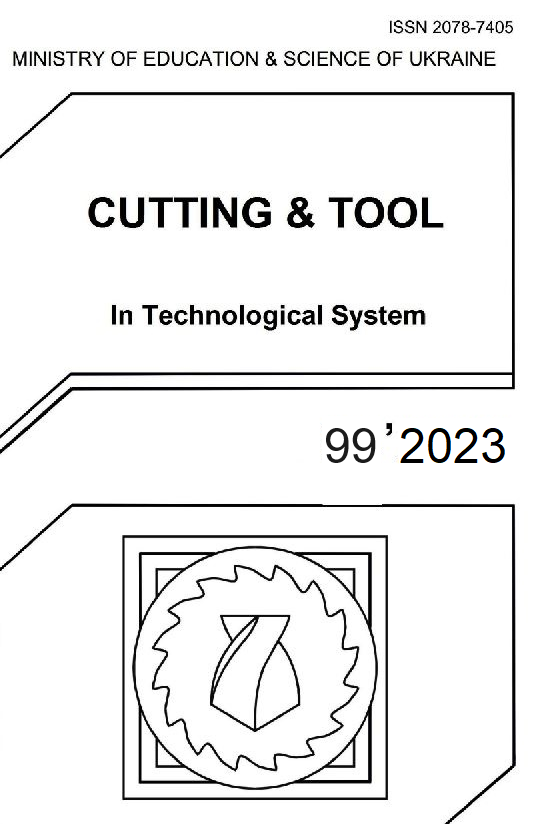TOPOGRAPHIC ADAPTABILITY IN THE DIAMOND GRINDING ZONE OF SUPERHARD MATERIALS
DOI:
https://doi.org/10.20998/2078-7405.2023.99.09Keywords:
superhard polycrystalline material, diamond grains, working surface of the grinding wheel, microrelief of diamond grains, concentration of diamond grains in the grinding wheelAbstract
A comprehensive theoretical and experimental analysis of technological topographic adaptability is carried out, based on an idealized description of the topographic parameters of the working surface of the grinding wheel, their changes during its wear and experimental laser scanning of the working surface of the grinding wheel and the processed superhard material (SHM). It has been established that the protrusion height of diamond grains affects the intensity of destruction (removal) of stock through a change in the number of working grains and the actual contact area of the SHM with the working part of the grinding wheel surface. In a controlled grinding process, it is possible to stabilize the working height of the grains in any of the 3 stages of their wear intensity, equating this intensity with the intensity of removal of the intergranular bond. A method has been developed for determining the actual contact area of the working surface of the grinding wheel and changing its technological adaptability. It has been established that in the process of topographic adaptability, the actual contact area can change by several orders of magnitude, respectively, the specific pressure at the contact of diamond grains with the SHM will change, and, consequently, the nature and intensity of their mutual destruction.
References
Modeling of the diamond grinding process by the finite element method [Electronic resource] : monograph / Fedorovych V. O., Fedorenko D. O., Romashov D. V., Ostroverkh Y. V., Pupan L. I.] ; National Technical University "Kharkiv Polytechnic Institute." –Kharkiv, 2023. 257 p. (in Ukrainian) – URI:https://repository.kpi.kharkov.ua/handle/KhPI-Press/64334.
Chi Y, Li H. Simulation and analysis of grinding wheel based on Gaussian mixture model. Frontiers of Mechanical Engineering, 2012;7(4):427–432.DOI https://doi.org/10.1007/s11465-012-0350-3
Frutani K, Ohguro N, et al. In-process measurement of topography change of grinding wheel by using hydrodynamic pressure. International Journal of Machine Tool and Manufacture, 2002;42:1447–1453.https://doi.org/10.1016/S0890-6955(02)00073-1
Ye R, Jiang X, Blunt L, Cui C, Yu Q. The application of 3D-motif analysis to characterize diamond grinding wheel topography. Measurement, 2016;77:73–79.https://doi.org/10.1016/j.measurement.2015.09.005
Amin A. Mokbel, T.M.A. Maksoud, Monitoring of the condition of diamond grinding wheels using acoustic emission technique, Journal of Materials Processing Technology; 101 (2000) 292–297https://doi.org/10.1016/S0924-0136(00)00433-7.
K.-C. Fan, M.-Z.Lee, J.-I.Mou, On-line non-contact system for grinding wheel wear measurement, International Journal Advanced Manufacturing Technology; 19 (2002) 14–22https://doi.org/10.1007/PL00003964.
Tönshoff HK, Peters J, Inasaki I, Paul T (1992) Modelling and simulation of grinding processes. CIRP Annals –Manufacturing Technology 41 (2):677–688 https://doi.org/10.1016/S0007-8506(07)63254-5.
Verkerk J (1977) Final report concerning CIRP cooperative work on the characterization of grinding wheel topography. Annals of the CIRP 26 (2):385–395.
Malkin S (1989) Grinding technology: Theory and applications of machining with abrasives. Society of Manufacturing Engineers, USA.
Hegeman J BJW (2000) Fundamentals of grinding: Surface conditions of ground materials. University of Groningen, Netherlands.
Kragelskii I.V., Dobychin M.N., Kombalov V.S. Friction and Wear Calculation Methods, Oxford: Pergamon Press, 1982.– 454 р.
Qiao G, Dong G, Zhou M (2013) Simulation and assessment of diamond mill grinding wheel topography. The International Journal of Advanced Manufacturing Technology 68 (9–12):2085-2093 https://doi.org/10.1007/s00170-013-4807-2
Downloads
Published
Issue
Section
License
Copyright Notice
Authors who publish with this Collection agree to the following terms:
1. Authors retain copyright and grant the Collection right of first publication with the work simultaneously licensed under a Creative Commons Attribution License that allows others to share the work with an acknowledgement of the work's authorship and initial publication in this Collection.
2. Authors are able to enter into separate, additional contractual arrangements for the non-exclusive distribution of the Collection's published version of the work (e.g., post it to an institutional repository or publish it in a book), with an acknowledgement of its initial publication in this Collection.
3. Authors are permitted and encouraged to post their work online (e.g., in institutional repositories or on their website) prior to and during the submission process, as it can lead to productive exchanges, as well as earlier and greater citation of published work.

